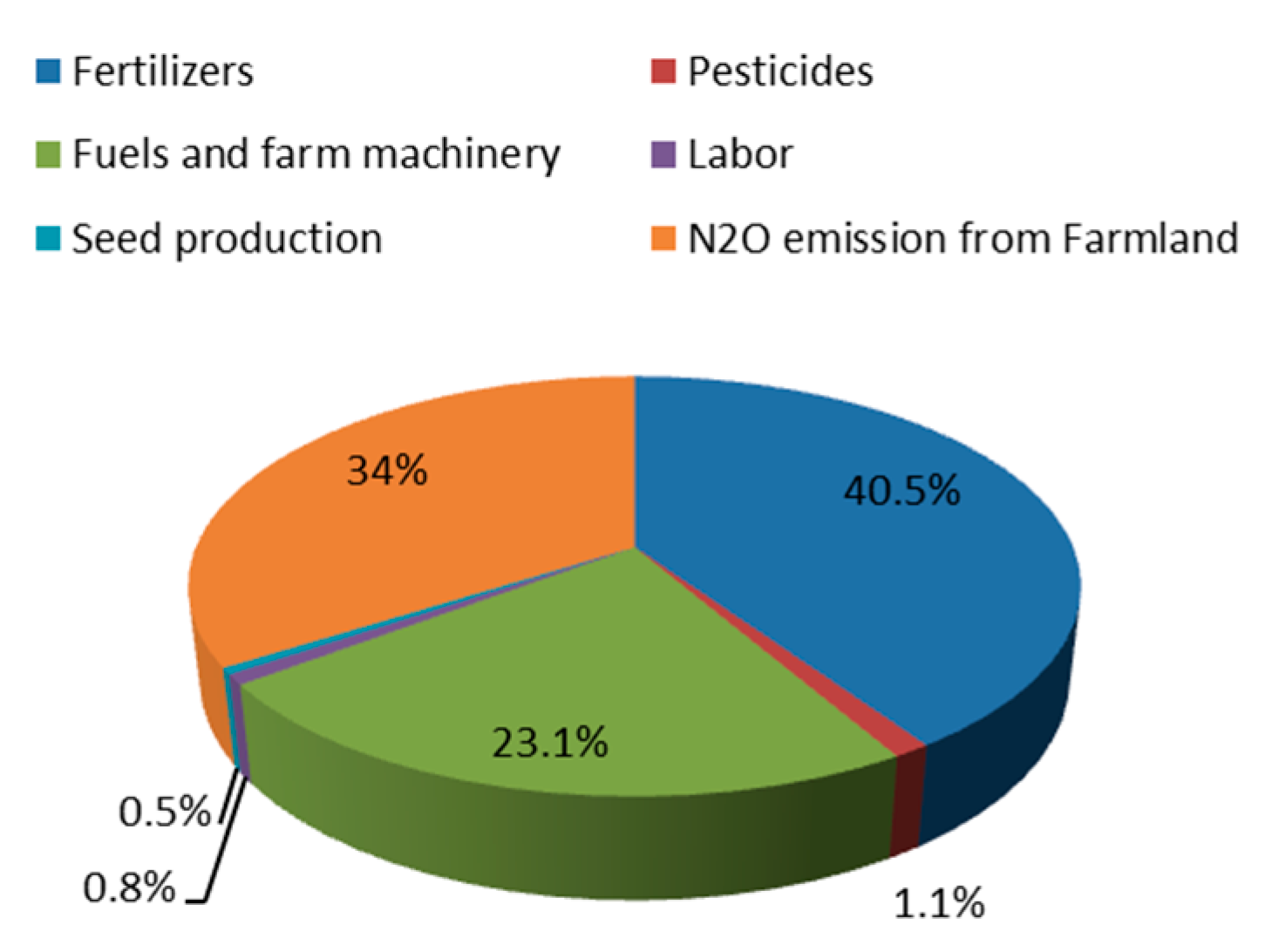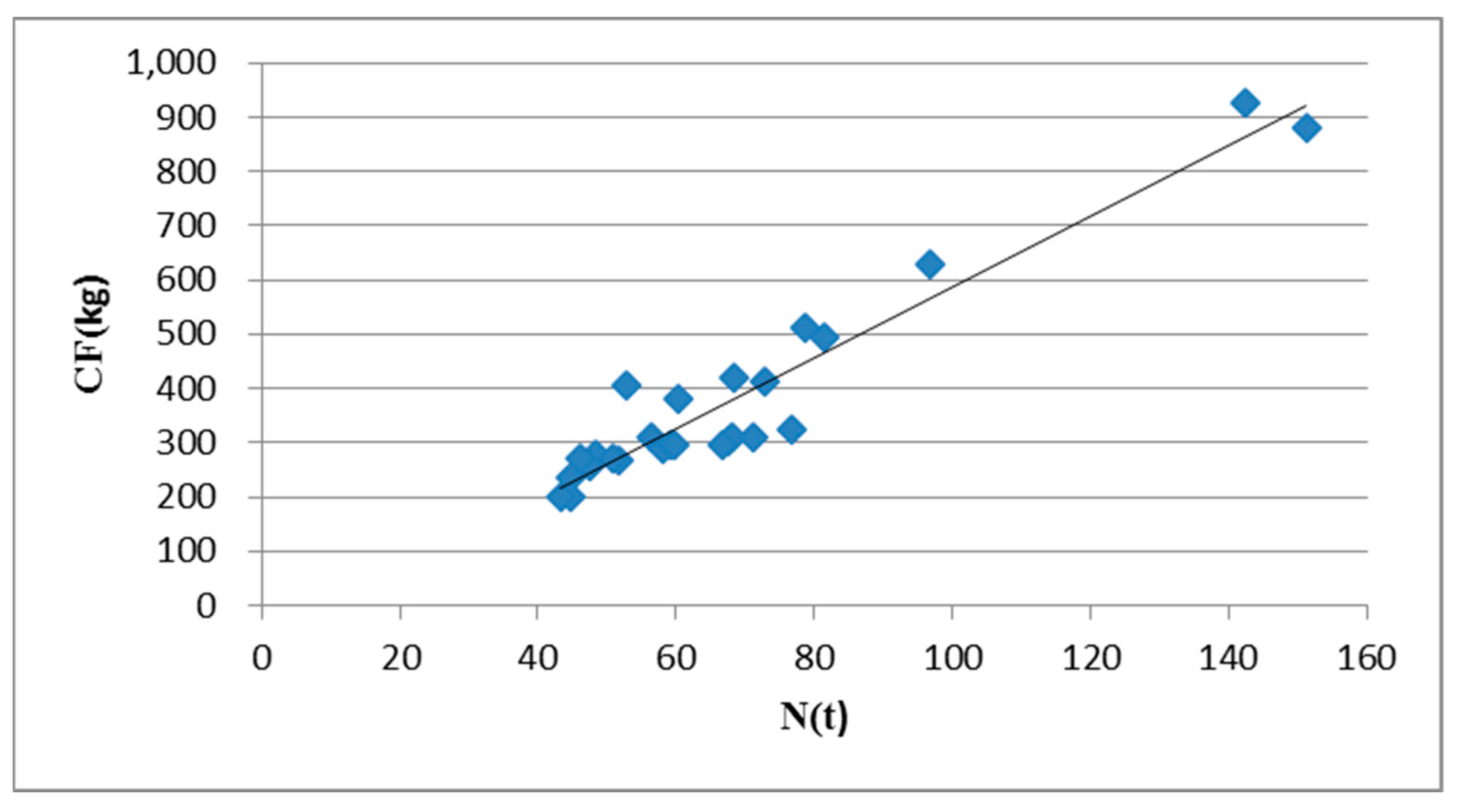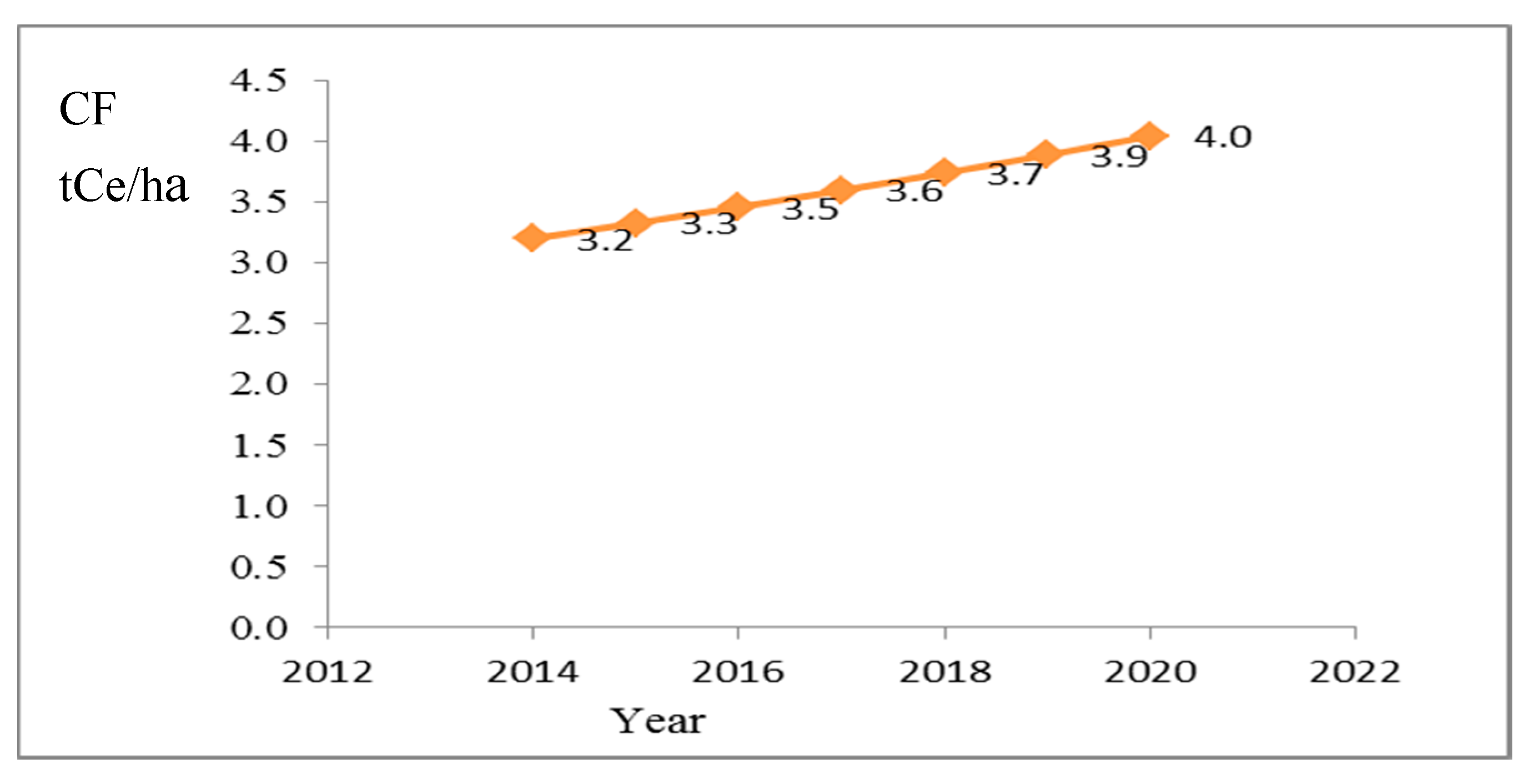Carbon Footprint Analysis for Mechanization of Maize Production Based on Life Cycle Assessment: A Case Study in Jilin Province, China
Abstract
:1. Introduction
2. Materials and Methods
2.1. Goal and Scope Definition
2.2. Function Unit
2.3. System Boundary

2.4. Methodology
| Emission Source | Emission Factor | Reference |
|---|---|---|
| N fertilizer | 4.96 kg Ce/kg | [22] |
| P fertilizer | 1.35 kg Ce/kg | [22] |
| K fertilizer | 0.58 kg Ce/kg | [22] |
| Pesticides | 5.10 kg Ce/kg | [15] |
| Herbicide | 6.30 kg Ce/kg | [15] |
| Diesel oil for machine | 3.32 kg Ce/L | [22] |
| Farm Labor | 0.86 kg Ce/person | [22] |
| Seeds | 1.22 kg Ce/kg | [11] |
| Farmland N2O | 0.01 kg N/kg | [23] |
3. Results and Discussion
3.1. Total Size of Carbon Footprint Emissions and Carbon Cost of Different Inputs
| Emission Source | Data Source | Activity Value | Carbon Emission in Area | Carbon Intensity in Production |
|---|---|---|---|---|
| L/ha | tCe/ha | tCe/t | ||
| Maize cultivation | Stubbing | 40 | 0.3984 | 0.0398 |
| (Diesel fuel) | Plow tillage | 30 | 0.2988 | 0.0299 |
| Seedling | 7 | 0.1195 | 0.0120 | |
| Weeding by Machinery | 1.5 | 0.0149 | 0.0015 | |
| Fertilizer by Machinery | 10 | 0.0498 | 0.0050 | |
| Harvest | 40 | 0.3984 | 0.0398 | |
| Transport | 15 | 0.1494 | 0.0149 | |
| Farm labor | 200 | 0.0490 | 0.0049 | |
| kg/ha | tCe/ha | tCe/t | ||
| Farm inputs | Nitrogen N | 450 | 2.2320 | 0.2232 |
| Phosphorus P | 151 | 0.2039 | 0.0204 | |
| Potassium K | 125 | 0.0725 | 0.0073 | |
| Herbicide | 9 | 0.0567 | 0.0057 | |
| Insecticide | 2 | 0.0102 | 0.0010 | |
| Fungicide | 1.05 | 0.0041 | 0.0004 | |
| Seeds | 25 | 0.0305 | 0.0031 | |
| N2O emission from farmland | 2.1073 | 0.2107 | ||
| Total | 6.1954 | 0.62 | ||


| Stubbling | Tillage | Seedling | Weeding by WC | Fertilizer by MC | Harvest | Transport | Total | |
|---|---|---|---|---|---|---|---|---|
| L/ha | 40 | 30 | 12 | 1.5 | 5 | 40 | 15 | 143.5 |
| t Ce/ha | 0.40 | 0.30 | 0.12 | 0.01 | 0.05 | 0.40 | 0.15 | 1.43 |
3.2. Forecast of Carbon Footprint
3.3. The Basis of the GM (1, 1) Model
| Time | Actual Value | Simulative Value | Absolute Error |
|---|---|---|---|
| 2006 | 2.3906 | 2.3906 | 0 |
| 2007 | 2.5158 | 2.4397 | 0.0302 |
| 2008 | 2.4587 | 2.5364 | 0.0316 |
| 2009 | 2.5964 | 2.6370 | 0.0156 |
| 2010 | 2.7393 | 2.7415 | 0.0008 |
| 2011 | 2.8722 | 2.8502 | 0.0077 |
| 2012 | 3.0358 | 2.9632 | 0.0239 |
| 2013 | 3.0337 | 3.0807 | 0.0155 |
| (avg) | 1.6% |

3.4. Comparisons with Other Regions’ Carbon Estimates from Crop Production
3.5. Uncertainty of Carbon Emissions Assessment
4. Conclusions
Acknowledgments
Author Contributions
Conflicts of Interest
References
- Food and Agriculture Organization (FAO). Final 2012 Data and Preliminary 2013 Data for 5 Major Commodity Aggregates Now Available. 2012. Available online: http://faostat.fao.org/site/339/default.aspx (accessed on 25 July 2014).
- Ministry of Agriculture of the People’s Republic of China. Domestic Maize Output Will Reach 216 Million Tons in 2014. Available online: http://acs.mofcom.gov.cn/sites/aqzn/aqjxnr.jsp?contentId=2837184448905 (accessed on 25 July 2014).
- Xie, J.P. Influence of Agricultural Mechanization on land integration. J. Shangxi Agric. Sci. 2015, 43, 486–488. [Google Scholar]
- Wang, L.Q. Considerations about the Necessity of the Scale Operation of Rural Farmland. Sci. Technol. Inf. Dev. Econ. 2004, 14, 89–90. [Google Scholar]
- McDougall, F.; White, P.; Franke, M.; Hindle, P. “Life Cycle Assessment” in Integrated Solid Waste Management: A Life Cycle Inventory; Blackwell Science: Malden, MA, USA, 2001. [Google Scholar]
- Abeliotis, K.; Detsis, V.; Pappia, C. Life cycle assessment of bean production in the Prespa National Park, Greece. J. Clean. Prod. 2013, 41, 89–96. [Google Scholar] [CrossRef]
- Beccali, M.; Cellura, M.; Iudicello, M.; Mistretta, M. Resource consumption and Environmental impacts of the agrofood sector: Life cycle assessment of Italian citrus-based products. Environ Manag. 2009, 43, 707–724. [Google Scholar] [CrossRef] [PubMed]
- Brentrup, F.; Küsters, J.; Kuhlmann, H.; Lammel, J. Application of the Life Cycle Assessment methodology to agricultural production: An example of sugar beet production with different forms of nitrogen fertilizers. Eur. J. Agron. 2001, 14, 221–233. [Google Scholar] [CrossRef]
- Nie, S.-W.; Gao, W.-S.; Chen, Y.-Q.; Sui, P.; Eneji, A.E. Use of life cycle assessment methodology for determining phytoremediation potentials of maize-based cropping systems in fields with nitrogen fertilizer over-dose. J. Clean. Prod. 2010, 18, 1530–1534. [Google Scholar] [CrossRef]
- Sahle, A.; Potting, J. Environmental life cycle assessment of Ethiopian rose cultivation. Sci. Total Environ. 2013, 443, 163–172. [Google Scholar] [CrossRef] [PubMed]
- Xu, M.O.; Xi, L.Z.; Shi, Y.C.; Qing, F.G. Energy Consumption and GHG emission of six biofuel pathways by LCA in (the) People’s Republic of China. Appl. Energy 2009, 86, S197–S208. [Google Scholar] [CrossRef]
- BP China. Calculator of Carbon Emission. 2007. Available online: http://www.bp.com/Sectiongenericarticle.do?categoryId=9011336&contented=7025421 (accessed on 25 July 2014).
- Wiedema, B.P.; Thrane, M.; Christensen, P.; Schmidt, J.; Løkke, S. Carbon footprint: A catalyst for life cycle assessment? J. Ind. Ecol. 2008, 12, 3–6. [Google Scholar] [CrossRef]
- Dubey, A.; Lal, R. Carbon footprint and sustainability of agricultural production systems in Punjab, India, and Ohio, USA. J. Crop Improv. 2009, 23, 332–350. [Google Scholar] [CrossRef]
- Wiedmann, T.; Minx, J. A definition of carbon footprint. In Ecological Economics Research Trends; Pertsova, C.C., Ed.; Nova Science Publishers: Hauppauge, NY, USA, 2008; Chapter 1; pp. 1–11. [Google Scholar]
- Hillier, J.; Hawes, C.; Squire, G.; Hilton, A.; Wale, S.; Smith, P. The carbon footprints of food crop production. Int. J. Agric. Sustain. 2009, 7, 107–118. [Google Scholar] [CrossRef]
- Department of Rural Social and Economic Survey. Statistical Yearbook of China Rural (1985–2011); China Statistics Press: Beijing, China, 2011.
- Statistical Bureau of Jilin Province. Jilin Year Book (1985–2014); China Statistics Press: Beijing, China, 2014.
- Nemecek, T.; von Richthofen, J.-S.; Dubois, G.; Casta, P.; Charles, R.; Pahl, H. Environmental Impacts of Introducing Grain Legumes into European Crop Rotations. Eur. J. Agron. 2008, 28, 380–393. [Google Scholar] [CrossRef]
- Suh, S.; Lenzen, M.; Treloar, G.J.; Hondo, H.; Horvath, A.; Huppes, G. System boundary selection in life-cycle inventories using hybrid approaches. Environ. Sci. Technol. 2004, 38, 657–664. [Google Scholar] [CrossRef] [PubMed]
- IPCC. Summary for Policy Makers of Climate change 2007: The Physical Science Basis. In Contribution of Working Group I to the Fourth Assessment Report of the Intergovernmental Panel on Climate Change; Cambridge University Press: Cambridge, UK, 2007. [Google Scholar]
- Deng, J.L. Grey Controlling System. Cent. Inst. Technol. 1982, 10, 9–18. [Google Scholar]
- Lal, R. Carbon emission from farm operations. Environ. Int. 2004, 30, 981–990. [Google Scholar] [CrossRef] [PubMed]
- Liu, X.H.; Xu, W.X.; Li, Z.J.; Zhu, Q.Q.; Yang, X.L.; Chen, B. The Missteps, Improvement and Application of Carbon Footprint Methodology in Farmland Ecosystems with the Case Study of Analyzing the Carbon Efficiency of China’s Intensive Farming. Chin. J. Agric. Resour. Reg. Plan. 2013, 34, 6–61. [Google Scholar]
- Cempel, C. Simple Condition Forecasting Techniques in Vibroacoustical Diagnostics Mech. Syst. Signal Process. 1987, 1, 75–82. [Google Scholar] [CrossRef]
- Heng, A.; Zhang, A.; Tan, A.; Mathew, J. Rotating Machinery Prognostics—State of the Art, Challenges and Opportunities Mech. Syst. Signal Process. 2009, 23, 724–739. [Google Scholar] [CrossRef]
- Kayacan, E.; Ulutas, B.; Kaynak, O. Grey System Theory-Based Models in Time Series Prediction. Expert Syst. Appl. 2010, 37, 1784–1789. [Google Scholar] [CrossRef]
- Liu, J.; Yang, H. China fights against statistical corruption. Science 2009, 325, 675–676. [Google Scholar] [CrossRef] [PubMed]
- Holz, C.A. The quality of China’s GDP statistics. China Econ. 2014, 30, 309–338. [Google Scholar] [CrossRef]
- Rawski, T.G. What is happening to China’s GDP statistics? China Econ. Rev. 2001, 12, 347–354. [Google Scholar] [CrossRef]
- Brodt, S.; Kendall, A.; Mohammadi, Y.; Arslan, A.; Yuan, J.; Lee, I.; Lingqust, B. Life Cycle Greenhouse Gas Emissions in California Rice Production. Field Crop. Res. 2014, 169, 89–98. [Google Scholar] [CrossRef]
- Hokazono, S.; Hayashi, K. Varibability in Environmental Impacts during Conversion from Conventional to Organic Farming: A Comparison among Three Rice Production Systems in Japan. J. Clean. Prod. 2012, 28, 101–112. [Google Scholar] [CrossRef]
- Blengini, D.A.; Busto, M. the Lifecycle of Rice: LCA of Alternative Agri-food Chain Management Systems in Vercelli (Italy). J. Environ. Manag. 2009, 90, 1512–1522. [Google Scholar] [CrossRef] [PubMed]
- Mondelaers, K.; Aertsens, J.; van Huylenbroeck, G. A Meta-analysis of the Differences in Environmental Impacts between Organic and Conventional Farming. Br. Food J. 2009, 111, 1098–1119. [Google Scholar] [CrossRef]
- Cheng, X.; Han, Ch. Sustainable agricultural development in China. World Dev. 1992, 20, 1127–1144. [Google Scholar] [CrossRef]
- Lo, F.; Xing, Y.Q. China’s Sustainable Development Framework—Summary Report; The United Nations University: Tokyo, Japan, 1999. [Google Scholar]
- Li, Y.; Zhang, W.; Ma, L.; Huang, G.; Oenema, O.; Zhang, F.; Dou, Z. An Analysis of China’s Fertilizer Policies: Impacts on the Industry, Food Security, and the Environment. J. Environ. Qual. 2014, 42, 972–981. [Google Scholar] [CrossRef] [PubMed]
- Huang, Y.; Tang, Y.H. An estimate of greenhouse gas (N2O and CO2) mitigation potential under various scenarios of nitrogen use efficiency in Chinese croplands. Glob. Chang. Biol. 2010, 16, 2958–2970. [Google Scholar] [CrossRef]
- Chen, J.; Huang, Y.; Tang, Y. Quantifying Economically and Ecologically Optimum Nitrogen Rates for Rice Production in South-eastern China. Agric. Ecosyst. Environ. 2011, 143, 195–204. [Google Scholar] [CrossRef]
- Chen, X.; Zhang, F.; Romheld, V.; Horlacher, D.; Schulz, R.; Boning-Zilkens, M.; Wang, P.; Claupein, W. Synchronizing N Supply from Soil and Fertilizer and N Demand of winter Wheat by an Improved Nmin Method. Nutr. Cycl. Agroecosyst. 2006, 74, 91–98. [Google Scholar] [CrossRef]
- Growth and Evolution in China’s Agricultural Support Policies. Available online: http://www.ers.usda.gov/media/1156829/err153.pdf (accessed on 5 August 2013).
- The National Development and Reform Commission Price Department. Compilation of Cost and Income Data of Agricultural Products in China; China Statistics Press: Beijing, China, 2014.
- Long, L.; Yang, S.; Li, X.; Zhang, F.; Christie, P. Interspecific Complementary and competitive Interactions between Intercropped Maize and Faba Bean. Plant Soil 1999, 212, 105–114. [Google Scholar] [CrossRef]
- Zhang, F.; Li, L. Using competitive and Facilitative Interactions in Intercropping Systems Enhances Crop Productivity and Nutrient-Use Efficiency. Plant Soil 2003, 248, 305–312. [Google Scholar] [CrossRef]
© 2015 by the authors; licensee MDPI, Basel, Switzerland. This article is an open access article distributed under the terms and conditions of the Creative Commons Attribution license (http://creativecommons.org/licenses/by/4.0/).
Share and Cite
Wang, H.; Yang, Y.; Zhang, X.; Tian, G. Carbon Footprint Analysis for Mechanization of Maize Production Based on Life Cycle Assessment: A Case Study in Jilin Province, China. Sustainability 2015, 7, 15772-15784. https://doi.org/10.3390/su71115772
Wang H, Yang Y, Zhang X, Tian G. Carbon Footprint Analysis for Mechanization of Maize Production Based on Life Cycle Assessment: A Case Study in Jilin Province, China. Sustainability. 2015; 7(11):15772-15784. https://doi.org/10.3390/su71115772
Chicago/Turabian StyleWang, Haina, Yingsheng Yang, Xiaoyi Zhang, and Guangdong Tian. 2015. "Carbon Footprint Analysis for Mechanization of Maize Production Based on Life Cycle Assessment: A Case Study in Jilin Province, China" Sustainability 7, no. 11: 15772-15784. https://doi.org/10.3390/su71115772
APA StyleWang, H., Yang, Y., Zhang, X., & Tian, G. (2015). Carbon Footprint Analysis for Mechanization of Maize Production Based on Life Cycle Assessment: A Case Study in Jilin Province, China. Sustainability, 7(11), 15772-15784. https://doi.org/10.3390/su71115772





